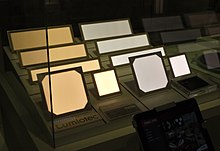
Back ثنائي مساري عضوي باعث للضوء Arabic Арганічны сьвятлодыёд BE-X-OLD ওএলইডি Bengali/Bangla Díode orgànic emissor de llum Catalan OLED Czech OLED Danish Organische Leuchtdiode German Οργανική φωτοδίοδος Greek OLED Esperanto Diodo orgánico de emisión de luz Spanish
 Prototype OLED lighting panels | |
| Type | LED |
|---|---|
An organic light-emitting diode (OLED), also known as organic electroluminescent (organic EL) diode,[1][2] is a type of light-emitting diode (LED) in which the emissive electroluminescent layer is an organic compound film that emits light in response to an electric current. This organic layer is situated between two electrodes; typically, at least one of these electrodes is transparent. OLEDs are used to create digital displays in devices such as television screens, computer monitors, and portable systems such as smartphones and handheld game consoles. A major area of research is the development of white OLED devices for use in solid-state lighting applications.[3][4][5]
There are two main families of OLED: those based on small molecules and those employing polymers. Adding mobile ions to an OLED creates a light-emitting electrochemical cell (LEC) which has a slightly different mode of operation. An OLED display can be driven with a passive-matrix (PMOLED) or active-matrix (AMOLED) control scheme. In the PMOLED scheme, each row and line in the display is controlled sequentially, one by one,[6] whereas AMOLED control uses a thin-film transistor (TFT) backplane to directly access and switch each individual pixel on or off, allowing for higher resolution and larger display sizes. OLEDs are fundamentally different from LEDs, which are based on a p-n diode crystalline solid structure. In LEDs, doping is used to create p- and n-regions by changing the conductivity of the host semiconductor. OLEDs do not employ a crystalline p-n structure. Doping of OLEDs is used to increase radiative efficiency by direct modification of the quantum-mechanical optical recombination rate. Doping is additionally used to determine the wavelength of photon emission.[7]
OLED displays are made in a similar way to LCDs, including manufacturing of several displays on a mother substrate that is later thinned and cut into several displays. Substrates for OLED displays come in the same sizes as those used for manufacturing LCDs. For OLED manufacture, after the formation of TFTs (for active matrix displays), addressable grids (for passive matrix displays), or indium tin oxide (ITO) segments (for segment displays), the display is coated with hole injection, transport and blocking layers, as well with electroluminescent material after the first two layers, after which ITO or metal may be applied again as a cathode. Later, the entire stack of materials is encapsulated. The TFT layer, addressable grid, or ITO segments serve as or are connected to the anode, which may be made of ITO or metal.[8] OLEDs can be made flexible and transparent, with transparent displays being used in smartphones with optical fingerprint scanners and flexible displays being used in foldable smartphones.
- ^ "Organic EL - R&D". Semiconductor Energy Laboratory. Retrieved 8 July 2019.
- ^ "What is organic EL?". Idemitsu Kosan. Archived from the original on 8 July 2019. Retrieved 8 July 2019.
- ^ Kamtekar, K. T.; Monkman, A. P.; Bryce, M. R. (2010). "Recent Advances in White Organic Light-Emitting Materials and Devices (WOLEDs)". Advanced Materials. 22 (5): 572–582. Bibcode:2010AdM....22..572K. doi:10.1002/adma.200902148. PMID 20217752. S2CID 205234304.
- ^ D'Andrade, B. W.; Forrest, S. R. (2004). "White Organic Light-Emitting Devices for Solid-State Lighting". Advanced Materials. 16 (18): 1585–1595. Bibcode:2004AdM....16.1585D. doi:10.1002/adma.200400684. S2CID 137230337.
- ^ Chang, Yi-Lu; Lu, Zheng-Hong (2013). "White Organic Light-Emitting Diodes for Solid-State Lighting". Journal of Display Technology. PP (99): 1. Bibcode:2013JDisT...9..459C. doi:10.1109/JDT.2013.2248698. S2CID 19503009.
- ^ "PMOLED vs AMOLED – what's the difference?". Oled-info.com. Archived from the original on 20 December 2016. Retrieved 16 December 2016.
- ^ Pearsall, Thomas (2010). Photonics Essentials, 2nd edition. McGraw-Hill. ISBN 978-0-07-162935-5. Archived from the original on 17 August 2021. Retrieved 24 February 2021.
- ^ "Schematics of OLED Structures with Encapsulation [image] | EurekAlert! Science News". Archived from the original on 17 April 2021. Retrieved 5 January 2020.